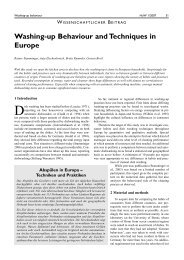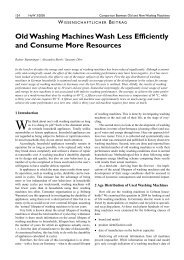Development of a novel mechatronic system for mechanical weed ...
Development of a novel mechatronic system for mechanical weed ...
Development of a novel mechatronic system for mechanical weed ...
Create successful ePaper yourself
Turn your PDF publications into a flip-book with our unique Google optimized e-Paper software.
5.3 Physical prototype <strong>of</strong> the hoeing equipment<br />
Results and discussion<br />
After the comprehensive analysis <strong>of</strong> the results observed with the virtual<br />
prototype the first physical prototype <strong>of</strong> the hoeing tool has been built. The<br />
selection <strong>of</strong> the appropriate driving engine <strong>for</strong> accurate rotational speed and<br />
position control <strong>of</strong> the hoeing tool required a determination <strong>of</strong> the average and<br />
maximum torque on the axis, during the <strong>weed</strong>ing process in field conditions.<br />
5.3.1 Determination <strong>of</strong> the maximum torque and nominal<br />
speed required<br />
To confirm that the designed construction can withstand the maximum load and<br />
to observe the torque value, experiments in the field conditions were conducted.<br />
The determination <strong>of</strong> the maximum torque was <strong>of</strong> crucial significance in order to<br />
choose a motor with adequate power <strong>for</strong> the hoeing tool. In the experiment the<br />
rotary hoeing tool with three implemented arms was pulled by a tractor and<br />
plugged to the cardan shaft <strong>of</strong> the tractor over a gear with 10:1 transmission<br />
ratio. The aim <strong>of</strong> the experiments was to acquire in<strong>for</strong>mation about the <strong>for</strong>ward<br />
speed, angular position <strong>of</strong> the hoeing tool and required torque <strong>for</strong> hoeing. The<br />
<strong>for</strong>ward speed can be calculated if the travelled distance and the time passed<br />
are known. Travelled distance in field conditions can be estimated with several<br />
methods. Methods which are based on the contact with the soil surface need to<br />
be avoided if high accuracy is required, because <strong>of</strong> the slipping effect which can<br />
occur in hard field conditions. One accepted non-contact method <strong>for</strong> estimation<br />
<strong>of</strong> the travelled distance is with <strong>system</strong>s based on the Doppler shift effect.<br />
Depending on the adjustment, such a <strong>system</strong> can provide up to 125 impulses<br />
per meter <strong>of</strong> travelled distance, which satisfies accuracy demands in the field<br />
experiments. For simple on-line acquisition <strong>of</strong> the tractor’s <strong>for</strong>ward position an<br />
RDS true ground speed sensor (TGSS) was chosen. The angular position <strong>of</strong> the<br />
hoeing was acquired with an incremental encoder attached to the hoeing tool’s<br />
shaft. This in<strong>for</strong>mation was used <strong>for</strong> calculation <strong>of</strong> the rotational speed <strong>of</strong> the<br />
hoeing tool.<br />
87





